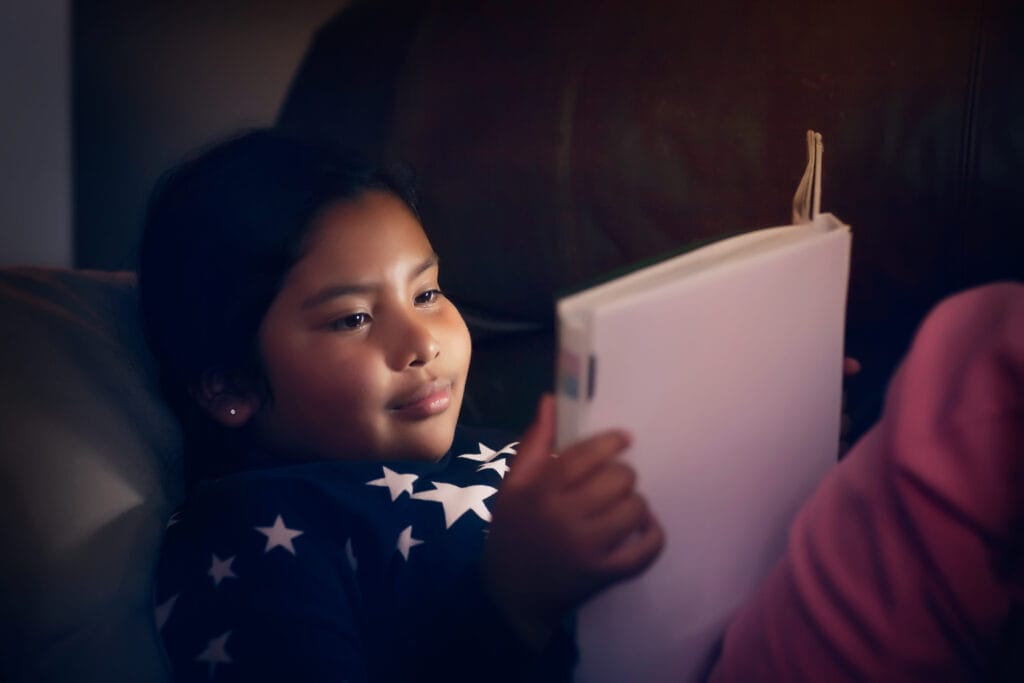
Lee esta publicación en español
Have you ever wondered how to instill healthy habits in your children? It’s all about family support! Healthy habits, including a nutritious diet, regular exercise, and good sleeping routines, are crucial for our wellbeing and development. For Latino children, it’s vital to address these aspects considering the cultural context and the prevalence of certain health conditions within this community. In this post we will look at how to foster healthy habits in Latino children through family support. Let’s dive in!
Healthy Habits in Children – Why it Matters

Before we begin, it’s important to understand why healthy habits are crucial. They influence a child’s physical health, academic success, and mental well-being. A child with good eating, exercise, and sleeping habits is more likely to grow into a healthy and successful adult.
Now, let’s explore how to foster these habits within a Latino family setting.
Embrace Healthy Eating Habits

In Latino culture, food isn’t just about nutrition; it’s a rich tapestry that carries tradition, family ties, and community bonding. Often, celebrations and gatherings revolve around large meals, making food a significant aspect of Latino identity and heritage.
Traditional Latino foods often include staples like rice, beans, tortillas, plantains, and meats, which can sometimes be high in starch, fats, and sugars. For instance, dishes like empanadas, flan, or churros, while delicious and rich in tradition, can contain substantial amounts of fats and sugars due to their method of preparation (frying, using heavy cream, etc.) or their ingredients.
However, this does not mean these foods are inherently unhealthy or should be avoided entirely. It’s all about balance and smart modifications. Many traditional dishes can be adapted to be healthier without losing the essence of their flavor or cultural significance.
Here are some ways to modify these recipes:
- Incorporate more fruits and vegetables: Adding more color to your meals not only makes them more visually appealing but also packs them with vitamins, minerals, and fiber. For instance, adding bell peppers, tomatoes, corn, and avocados to a traditional taco dish can significantly boost its nutritional value.
- Choose lean proteins: Traditional dishes often use fatty cuts of meat. By choosing lean proteins like chicken, turkey, or fish, or even plant-based proteins like beans or lentils, you can reduce the fat content of your meals.
- Switch to whole grains: Instead of using white rice or regular flour tortillas, switch to brown rice or whole grain tortillas. These alternatives are higher in fiber and keep you feeling full longer.
- Modify cooking methods: Frying is a common method of cooking in many traditional Latino dishes, but it can increase the fat content of the meal. Frying with lard, which is animal fat, can add a rich flavor to foods, but it is also high in saturated fats. If you’re looking for healthier alternatives, several oils are often recommended including Canola Oil, Safflower Oil, and Corn Oil. These oils may be considered healthier than lard, but limiting the number of fried foods you eat is the best way to maintain good health. You can also use methods like grilling, baking, or steaming to reduce the amount of added fats.
- Reduce sugar: Limit the number of sweet drinks (regular or diet). Also limit energy drinks and gatorade. If you add sugar to drinks you can swap sugar for natural sweeteners like fruits or honey.
Remember, the goal is not to abandon cultural foods but to find a balance that maintains the essence of these traditional dishes while promoting health and well-being.
Create a Family Meal Plan
Create a family meal plan that includes a variety of vegetables, lean proteins, and whole grains. Involve your children in the planning and preparation to make them more interested in eating healthily.
Make Physical Activity Fun

Incorporating physical activity into daily routines can seem challenging, but it’s easier when you make it fun.
Family Activities
When it comes to cultivating healthy habits in children, promoting family involvement in physical activities is key. Not only does this reinforce a culture of health and fitness, but it also helps children view exercise as a fun and normal part of life, rather than a chore. Plus, these activities can foster bonding time and create shared memories, strengthening family ties.
There are countless activities suitable for all fitness levels and ages. Here are some examples:
- Hiking: If you live near a nature reserve or park, hiking can be a wonderful way to get the family moving and appreciate the outdoors. It can range from light walks to more challenging uphill climbs, depending on your family’s fitness level.
- Soccer Game: Organizing a friendly family soccer match at a local park can be a fun and exciting way to exercise. It’s a high-energy activity that can help develop teamwork and coordination skills.
- Dancing: Dancing is an excellent cardiovascular activity, and it can also improve balance and coordination. Choose some upbeat Latino music and organize a family dance-off. Salsa, merengue, bachata, or reggaeton can make for a fun and lively session!
- Gardening: Gardening can be a surprisingly good workout. Digging, planting, weeding, and watering provide physical activity while allowing you to enjoy nature. Plus, if you plant fruits and vegetables, it can also encourage healthier eating habits.
- Biking: If everyone in the family knows how to ride a bike, consider going for a family bike ride. It’s an excellent way to explore your neighborhood or local parks.
- Cooking Together: While it may not seem like a physical activity, cooking involves a lot of standing, moving around, and using your hands. Making a meal together as a family can be a bonding experience and an opportunity to educate kids about nutrition.
- Water Activities: If you have access to a pool or beach, swimming, playing water polo, or even just tossing a ball around in the water can be great exercise and a way to cool down on hot days.
Remember, the goal of these activities isn’t to exhaust everyone but to get everyone moving, spend quality time together, and instill a love for an active lifestyle in children. Choose activities that are suitable and enjoyable for your family, and the habits are more likely to stick!
Prioritize Quality Sleep

Sleep is a vital part of a child’s growth and development. It’s during sleep that the body gets the rest it needs to repair and rejuvenate itself. For children, the amount of sleep is even more critical because it directly impacts mental and physical development.
Here’s how you can ensure a good night’s sleep and sleep for your child:
Maintain a Regular Sleep Schedule
A regular sleep schedule means going to bed and waking up at the same time every day. Consistency is key here. By maintaining a regular sleep schedule, and bedtime routine even on weekends, you help regulate your child’s internal body clock, also known as the circadian rhythm.
When the circadian rhythm is stable, your child’s body will naturally know when it’s time to go to bed and fall asleep and when it’s time to wake up. This can make falling asleep easier and can also help your child stay asleep throughout the night.
Create a Healthy Sleep Environment
The environment in which your child sleeps plays a big role in the quality of their sleep. A healthy sleep environment is one that promotes relaxation and is conducive to better sleep itself. Here are some elements to consider:
- Quiet: Loud noises can disturb your child’s ability to fall asleep. Consider using a white noise machine or fan to drown out noise if needed.
- Dark: Light can interfere with sleep. Consider using blackout curtains or a sleep mask for your child. Also, limit the use of electronic devices before bed as the light from screens can interfere with the body’s natural sleep-wake cycle.
- Cool: The temperature of the room can affect sleep quality. Most people sleep best in a slightly cool room. Around 65 degrees Fahrenheit (18.3 degrees Celsius) is often recommended, but it depends on personal preference.
- Comfortable: Make sure your child’s bed is comfortable. The mattress and pillows should support your child’s body well. Also, use bedding that’s appropriate for the room’s temperature.
By focusing on these two key areas – a regular sleep schedule and a healthy sleep environment – you can help ensure your child gets the quality sleep they need for optimal growth and development.
Nurture Mental and Emotional Health

Fostering mental and emotional health is as important as physical health.
Encourage Expressions
Encouraging your children to express their feelings and thoughts is essential for their emotional development and mental well-being. This involves creating an open and safe environment where your children feel comfortable sharing their emotions, ideas, concerns, and aspirations.
Open communication allows you to understand what your child is going through. It’s a chance to provide comfort, guidance, and support. It also helps children understand their own feelings and learn how to manage them effectively, which is a crucial life skill.
Active Listening
Show your child that you are interested in what they have to say. This means not interrupting, making eye contact, responding appropriately, and reflecting back what they’ve said to show understanding.
Ask Open-Ended Questions
These type of questions encourage more than a “yes” or “no” response and give your child an opportunity to express their thoughts and feelings more deeply.
Normalize Emotions
Assure your child that it’s okay to have and express different emotions, both positive and negative.
Model Expressiveness
Be open about your own feelings and thoughts, as children often learn by observing the adults in their lives.
Make Time for Relaxation
In our often fast-paced and busy world, teaching children the importance of relaxation and downtime is vital. Relaxation activities not only help reduce stress but also foster creativity, improve focus, and promote overall mental well-being.
Relaxation activities are those that your child finds enjoyable and that allows them to unwind and take a break from their usual tasks or routines. Here are some examples:
- Reading: This activity can transport children to different worlds, foster imagination, and improve language skills. Create a cozy reading nook to make the experience more inviting.
- Painting or Drawing: These activities allow children to express their creativity and feelings in a non-verbal way. Plus, focusing on their artwork can have a calming effect.
- Listening to Music: Music can significantly influence our mood. Soft, slow music can help your child relax, while upbeat music can be great for releasing energy through dancing.
- Spending Time in Nature: Whether it’s a walk in the park, a picnic, or bird watching, spending time outdoors can be refreshing and calming.
Remember, the goal is not what they do but that they enjoy it and it allows them to relax. Let your child choose the activity that suits them best and incorporate it into their routine to promote a balanced lifestyle.
Encourage Social Interactions
Social interactions play a crucial role in a child’s development. These interactions help children learn how to communicate, cooperate, and solve problems. They also contribute to emotional understanding and the ability to form friendships.
Encouraging your child to interact with others can involve various social contexts. Interactions with peers can help your child learn about cooperation, sharing, and dealing with conflicts. Interaction with family members can instill a sense of belonging, security, and identity. Meanwhile, participating in community events or activities can help your child understand their role within the wider society.
Teach Respect and Empathy
Respect and empathy are foundational values for forming and maintaining healthy relationships. Respect involves acknowledging and appreciating the rights, beliefs, and individuality of others. Empathy, on the other hand, is the ability to understand and share the feelings of others, enabling your child to respond compassionately in social situations.
By encouraging social interactions and teaching respect and empathy, you’re equipping your child with vital life skills and helping them develop into well-rounded individuals.
The Role of Family Support

Family support is the pillar of fostering healthy habits in children. Here’s how it helps:
It Models Healthy Habits
Children often learn by observing and imitating the adults in their lives. Therefore, parents and family members can significantly influence a child’s lifestyle and behavior. If a child sees their parents eating balanced meals, participating in regular physical activity, and prioritizing restful sleep, they are more likely to adopt these behaviors themselves.
For example, if a parent incorporates fruits and vegetables into every meal, the child can develop a preference for these foods. If a child observes their family taking daily walks or dancing to their favorite music, physical activity becomes normalized and associated with fun. Similarly enough sleep is equally as important, if a family follows a consistent sleep schedule, the child understands the importance of adequate rest.
It Provides Emotional Support
Emotional support from family members can be a major driving force behind a child’s motivation to adopt and maintain healthy habits. This support can come in many forms, such as encouraging words, validation of efforts, and showing understanding when challenges arise.
For instance, if a child is hesitant about trying a new physical activity, family members can offer words of encouragement and even participate in the activity with the child, thus providing a safe and supportive environment for them to try new things. This positive reinforcement can help the child develop self-confidence and resilience, both important for maintaining a healthy lifestyle in the long run.
It Reinforces Positive Behavior
When children engage in positive behavior – like choosing a piece of fruit over a sugary snack, drinking water instead of a soda, or actively participating in a family fitness activity – recognition and praise from their family can reinforce these actions. This reinforcement makes it more likely that the child will repeat these behaviors in the future.
Positive reinforcement can be as simple as verbal praise, such as saying “Great job choosing an apple for your snack!” or “I’m proud of you for drinking water with your meal!” Alternatively, it could be a reward system where the child earns points for healthy choices, which can be traded for a non-food reward like a family outing or a new book.
By modeling healthy habits, providing emotional support, and reinforcing positive behavior, families play a vital role in fostering children’s healthy habits. This support creates a nurturing environment where children are more likely to thrive and maintain these habits into adulthood.
Conclusion

Fostering healthy habits in Latino children is not a one-day job. It’s an ongoing process that requires consistency and family support. But the rewards are immeasurable – a healthier, happier child who grows up to be a responsible and successful adult.
Embrace these practices in your family, and let’s build a healthier Latino community together!
To learn more about the Fresh-LC program, or to inquire, complete this form: FRESH-LC Online Screen / Formulario de Interés en Línea Para FRESH-LC (ucsd.edu)


